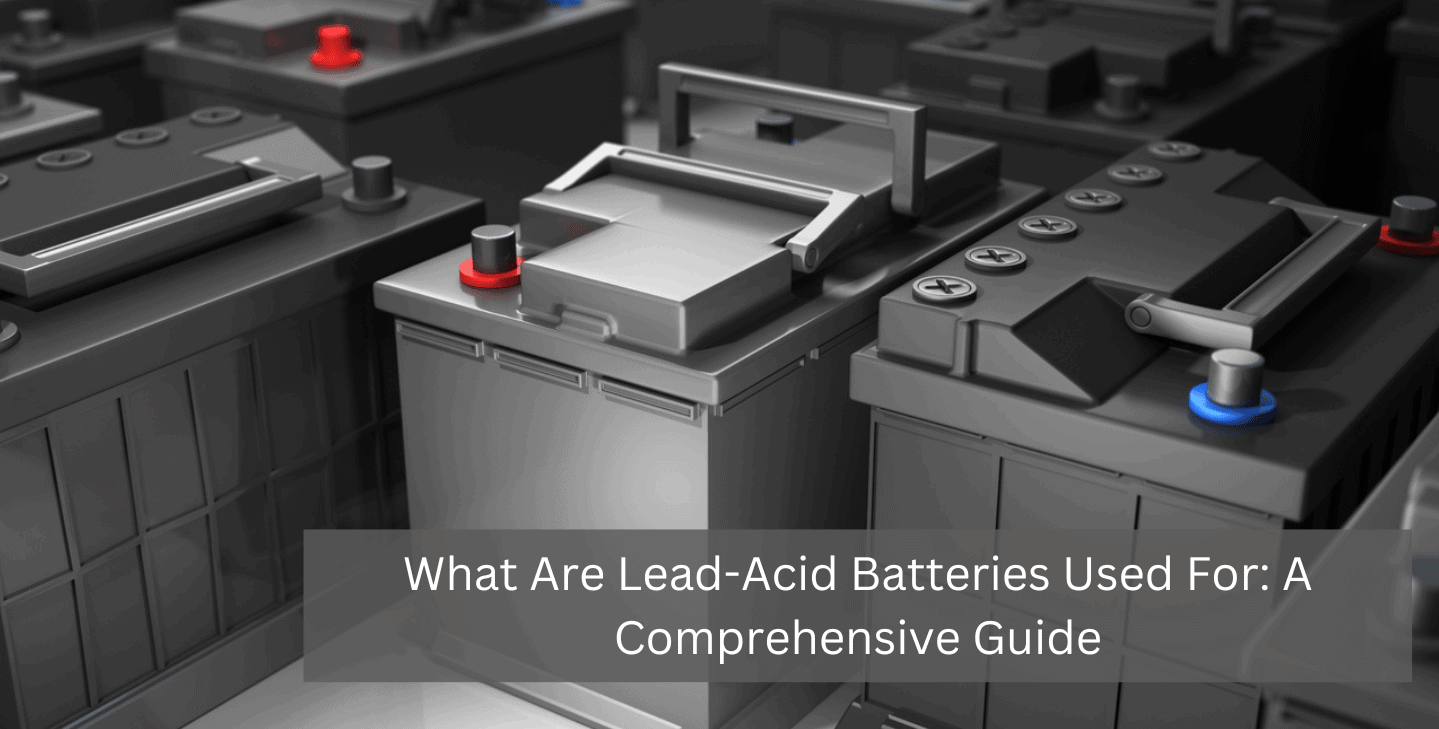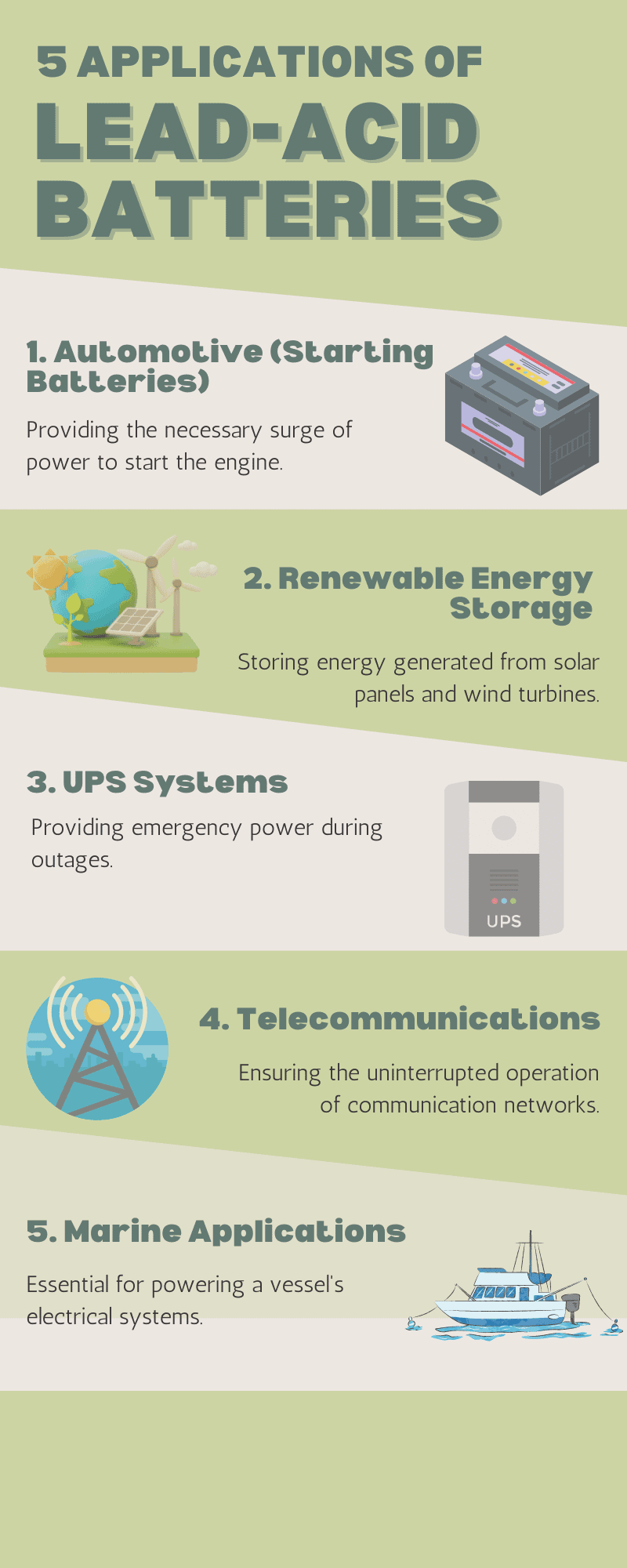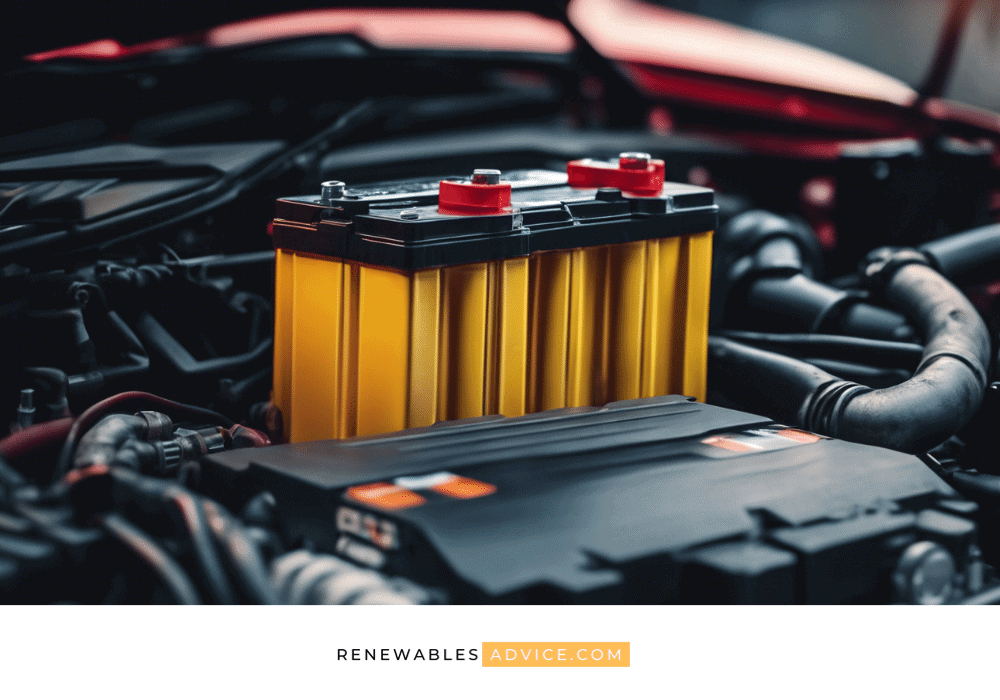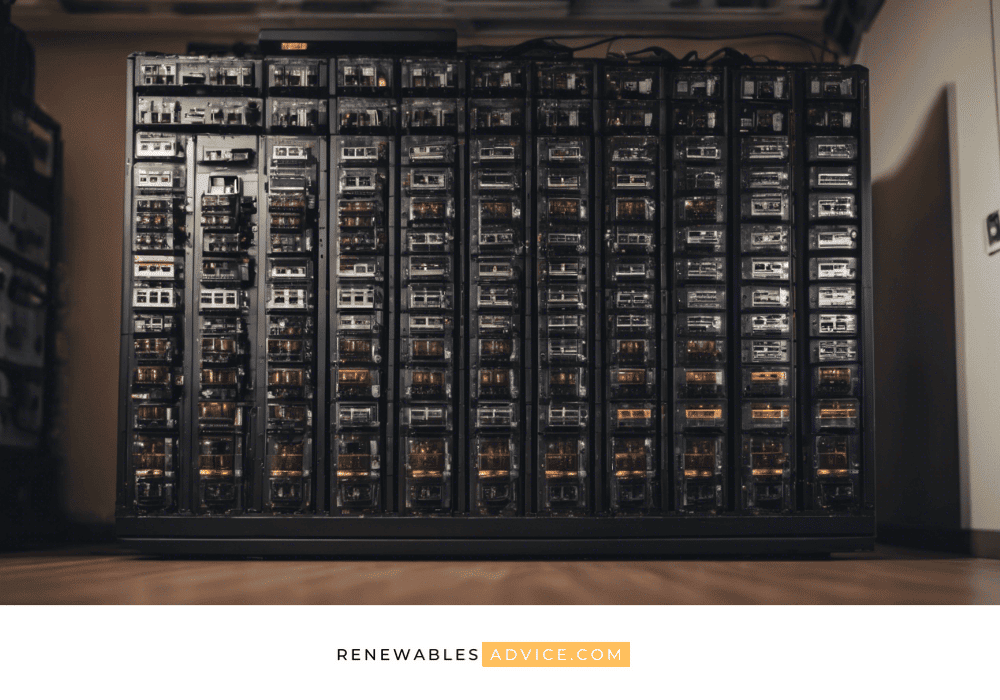What Are Lead-Acid Batteries Used For: A Comprehensive Guide
What Are Lead-Acid Batteries Used For: A Comprehensive Guide
What Are Lead-Acid Batteries Used For: A Comprehensive Guide

Lead-acid batteries are essential in various fields due to their reliability and cost-effectiveness. They are used for starting cars, powering remote telecommunications systems, and in industrial applications for running heavy machinery. In renewable energy systems, they are paired with solar panels, efficiently storing energy and handling high voltage and repeated discharge cycles. Their role in recycling processes also highlights their environmental significance. These batteries are not just about storing energy; they transform how we interact with our world, proving to be indispensable in modern technology and sustainable solutions.
In the following sections, we will explore the myriad of ways in which these batteries are used, their cost benefits, and how they continue to evolve and shape the landscape of energy storage and usage.
Key Takeaways
- Versatile Applications Across Industries: Lead-acid batteries are pivotal in many sectors due to their reliability and cost-effectiveness. They are not only crucial for starting and powering electrical systems in automotive applications but also serve as essential components in renewable energy storage, particularly in solar and wind systems. Their role also extends to critical backup power sources in UPS systems, ensuring continuity in data centers, hospitals, and telecommunications, as well as providing necessary power in marine applications.
- Technological Advancements and Efficiency: Lead-acid batteries have evolved significantly, with advancements like Valve-Regulated Lead Acid (VRLA) and Deep-Cycle batteries enhancing their efficiency and application range. These improvements make lead-acid batteries more adaptable, and capable of handling high voltage and repeated discharge cycles, especially in renewable energy systems where they store energy from solar panels or wind turbines for later use.
- Sustainability and Lifecycle Management: The guide emphasises the environmental significance of lead-acid batteries, highlighting their role in recycling processes and lifecycle management strategies aimed at sustainability. Despite their use of hazardous materials, efforts in recycling and innovative reuse solutions underline the industry's commitment to minimising the environmental impact while maximising efficiency and utility in various applications.

What are Some Applications of Lead-Acid Batteries?
Lead-acid batteries, known for their reliability and cost-effectiveness, play a crucial role in various sectors. Here are some of their primary applications:
- Automotive (Starting Batteries): Lead-acid batteries are extensively used in the automotive industry, primarily as starting batteries. They provide the necessary surge of power to start the engine and are designed to deliver high current for a short duration. Additionally, they power essential electrical components in vehicles, such as lights, infotainment systems, and air conditioning when the engine is off.
- Renewable Energy Storage (Solar and Wind Systems): In renewable energy, lead-acid batteries are pivotal for storing energy generated from solar panels and wind turbines. They are particularly valued in off-grid solar systems for their ability to store excess energy during peak production times, which can then be used during periods without sunlight or wind.
- Backup Power (UPS Systems): Uninterruptible Power Supply (UPS) systems commonly use lead-acid batteries to provide emergency power during outages. These batteries ensure the continuous operation of critical equipment in settings like data centers, hospitals, and telecommunications facilities, safeguarding against data loss and operational disruptions.
- Telecommunications: Lead-acid batteries serve as a reliable backup power source in telecommunications infrastructure. They ensure the uninterrupted operation of communication networks, especially in areas with unstable power supply, by providing consistent power to cell towers and other communication equipment.
- Marine Applications: In the marine sector, lead-acid batteries are essential for powering a vessel's electrical systems, including navigation, lighting, and communication devices. They are designed to withstand harsh marine environments and are often used as a reliable source of backup power for critical onboard systems.
Each of these applications leverages the unique characteristics of lead-acid batteries, such as their ability to deliver high power bursts, durability, and cost-effectiveness, making them an indispensable component in various technological and industrial domains.
While lead-acid batteries serve a wide array of applications, let's look into what truly sets them apart in terms of power and durability across these uses.
What Distinguishes Lead Acid Batteries in Terms of Power and Durability for Various Uses?
When we talk about energy storage, lead-acid batteries stand out for their robust power output and durability. These qualities make them exceptionally suitable for a wide range of applications, from starting a car to running heavy industrial machinery. The key to their performance lies in their electrodes and the sulfuric acid electrolyte, which together facilitate a reliable discharge and charging cycle. This combo keeps them going strong, cycle after cycle, making them reliable for automotive needs where consistent power can't be compromised.
Now, compared to the latest battery tech, lead-acid batteries have a lower energy density compared to lithium-ion batteries, but they compensate with their robustness and cost-effectiveness for large-scale energy storage. This is key in industrial applications, where machinery demands a steady and reliable energy source.
And here’s a kicker: their maintenance needs, often seen as a hassle, actually help them last longer. Regular maintenance can extend the life of lead-acid batteries, unlike some maintenance-free options like lithium-ion or nickel-metal hydride batteries, which may have a shorter lifespan in demanding applications.
The combination of dependable power, cost-effectiveness, and longevity positions lead-acid batteries as a top choice in both automotive and industrial applications. Their enduring presence in these sectors is a testament to their tailored fit for demanding energy requirements and challenging environments.
Understanding the unique strengths of lead-acid batteries leads us naturally to explore their pivotal role in the automotive industry.

Are Lead-Acid Batteries Used in Automotive Applications?
Lead-acid batteries are a cornerstone of the automotive industry, serving two primary functions: starting engines and powering electrical systems in vehicles.
Starting Engines: The primary role of lead-acid batteries in automobiles is to start the engine. When you turn the ignition key, the battery delivers a burst of energy to the starter motor, which then cranks the engine. This process requires a significant amount of current, typically in the range of 200 to 600 amps. Lead-acid batteries are particularly suited for this task due to their ability to provide high power output in short bursts, ensuring reliable engine starts.
The battery's role in starting the engine is crucial, especially in colder climates where engine oil thickens and makes starting the engine more challenging. The high cold cranking amps (CCA) rating of lead-acid batteries signifies their effectiveness in such conditions, providing the necessary power to overcome resistance and start the engine.
Powering Electrical Systems: Beyond starting the engine, lead-acid batteries also supply power to various electrical components in the vehicle. This includes essential systems like headlights, taillights, and windshield wipers, as well as comfort features such as the radio, infotainment systems, and air conditioning. When the engine is running, the alternator generates electricity and recharges the battery. However, when the engine is off, it's the battery that powers these electrical systems.
The battery's role becomes even more critical in modern vehicles equipped with advanced electronics, safety systems, and convenience features. It ensures that these systems remain operational, providing safety and comfort to the occupants.
In summary, lead-acid batteries in automotive applications are indispensable for both starting the engine and powering a vehicle's electrical systems. Their reliability, efficiency, and ability to deliver high current make them the preferred choice in the automotive sector. Beyond this sector, recent technological advancements have significantly expanded the role of lead-acid batteries in renewable energy solutions.
What Are the Key Advancements in Lead Acid Battery Technology for Renewable Energy?
Lead-acid batteries are getting some exciting updates. These updates are making them even more useful for storing renewable energy like solar and wind power. Let's dive into some of the cool new features that are making lead-acid batteries a strong contender in the renewable energy field:
- Valve-Regulated Lead Acid (VRLA) Batteries: VRLA batteries are a big step forward. They don't need you to add water to them, which makes them easier to use and safer. This is great for renewable energy setups because it means less fuss and more reliability.
- Deep-Cycle Batteries: These batteries are made for the long run. They can be used and recharged many times, which is perfect for solar and wind energy. They make sure you have power even when the sun isn't shining or the wind isn't blowing.
- Smart Charging: With smart charging, these batteries get charged just the right amount. This helps them last longer and work better, which is key for using them with renewable energy sources.
A review in Frontiers titled 'Revitalizing lead-acid battery technology: a comprehensive review on material and operation-based interventions with a novel sound-assisted charging method' also mentions two other advancements:
- Lead-Carbon Batteries: By incorporating carbon into the negative active material (NAM), lead-carbon batteries boast improved charge acceptance and reduced sulfation, a common issue that shortens battery life. This innovation enhances the performance of lead-acid batteries under partial state of charge (PSoC) conditions, making them more resilient and efficient in renewable energy storage (1).
- Sound-Assisted Charging Method: A novel approach to charging, this method uses sound waves to improve the charging process, potentially increasing the efficiency and lifespan of lead-acid batteries. While still under research, this innovative technique could revolutionise how lead-acid batteries are charged in renewable energy applications, making them even more competitive with other battery technologies (1).
These advancements are making lead-acid batteries a more attractive option for renewable energy storage. They're showing that even an old technology can learn new tricks and play a big part in our move towards more sustainable energy solutions. These advancements pave the way for lead-acid batteries to play a crucial role in energy storage, particularly within photovoltaic (PV) systems.

In What Ways Are Lead-Acid Batteries Used for Energy Storage in PV Systems?
When it comes to solar power, lead-acid batteries have carved a niche in photovoltaic (PV) systems. Their integration in these systems is pivotal for harnessing and storing solar energy. As sunlight is intermittent, lead-acid batteries ensure that the energy captured during sunny periods is not wasted but stored for later use. This storage capability is essential for maintaining a stable power supply, especially during periods without sunlight.
The process involves the conversion of solar energy into electrical energy, which is then stored in the battery. These batteries are adept at handling the charge and discharge cycles required in PV systems, making them a reliable choice for solar energy storage. Their ability to provide a steady voltage output even under fluctuating solar conditions is a key advantage.
Lead-acid batteries are beneficial for their cost-effectiveness when compared to other battery technologies. This affordability, coupled with their proven track record in energy storage, makes them an attractive option for residential and commercial PV systems. Their robustness and longevity are essential in applications where consistent energy access is critical.
Maintenance? Yeah, they need a check-up now and then. But keeping an eye on them means they last longer and work better. That’s key for making sure your solar setup keeps doing its thing effectively. The MDPI article titled 'Battery Storage Technologies for Electrical Applications: Impact in Stand-Alone Photovoltaic Systems' provides an overview of battery storage technologies for renewable energy applications, focusing on lead-acid batteries. It discusses the environmental impact of batteries in energy systems, particularly in a stand-alone photovoltaic system. Lead-acid batteries are highlighted for their commercial maturity and cost-effectiveness. The study evaluates the greenhouse gas impact of lead-acid batteries over a 25-year project lifespan, emphasising strategies to minimise environmental impact. It aims to guide battery selection for sustainable energy solutions. The research addresses a critical gap in understanding battery lifecycle impact, offering insights for future energy system planning (2). As we consider their application in PV systems, it's important to weigh the specific pros and cons of using flooded lead-acid batteries in solar power setups.
What are the Pros and Cons of Flooded Lead Acid Batteries for Solar Power Systems?
Flooded lead acid batteries offer a blend of affordability and reliability for solar power systems, but they come with specific maintenance needs. Discover the detailed pros and cons of using these batteries in solar setups to make an informed decision for your energy needs.
Pros:
- Cost-Effective: They are generally more affordable upfront compared to other types of solar batteries.
- High Energy Capacity: Ideal for off-grid systems, they can store substantial energy for use during non-sunny periods.
- Proven Reliability: With a long history in energy storage, they are a time-tested solution for solar power.
Cons:
- Regular Maintenance: They require frequent water top-ups and cleaning to maintain efficiency.
- Shorter Lifespan: Compared to newer technologies, they may need replacement sooner.
- Ventilation Needs: Emitting hydrogen gas, they require well-ventilated installation spaces for safety.
Understanding these aspects is crucial for integrating flooded lead acid batteries effectively into your solar power system. For a deeper dive into their suitability for your specific setup, explore our comprehensive guide on the pros and cons of flooded lead acid batteries for solar systems.

Are Lead-Acid Batteries Used in UPS Systems?
Lead-acid batteries are integral to Uninterruptible Power Supply (UPS) systems, providing a reliable source of backup power in various settings. Their role in UPS systems highlights their importance in maintaining continuity and preventing disruptions in critical operations.
Emergency Power Source: In a UPS system, lead-acid batteries act as an emergency power source. When there is a power outage or fluctuation in the main supply, the UPS system instantly switches to battery power, ensuring that connected devices continue to operate without interruption. This seamless transition is vital in settings like data centers, hospitals, and telecommunications facilities, where even a brief loss of power can lead to significant data loss, equipment damage, or critical service disruptions.
Design and Capacity: Lead-acid batteries used in UPS systems are typically designed for deep discharge and long-duration backup. Unlike automotive batteries, which deliver short, high-current bursts for starting engines, UPS batteries provide a steady current over a more extended period. This design is crucial for ensuring that the UPS can maintain power long enough for a safe shutdown of equipment or until the main power supply is restored.
Maintenance and Lifecycle: Regular maintenance is essential for ensuring the longevity and reliability of lead-acid batteries in UPS systems. This includes periodic testing, cleaning of terminals, and ensuring proper charging practices. While they are known for their durability and cost-effectiveness, lead-acid batteries in UPS systems do have a finite lifespan and will eventually require replacement. Proper maintenance can significantly extend this lifespan, ensuring consistent performance over the years.
Applications: The use of lead-acid batteries in UPS systems spans a wide range of applications. In corporate environments, they protect computers and servers from data loss. In industrial settings, they ensure that machinery and production lines are not abruptly halted. In healthcare facilities, they are crucial for keeping life-saving equipment operational during power outages.
In summary, lead-acid batteries are a key component of UPS systems, providing a reliable and efficient solution for emergency power backup. Their ability to deliver consistent power over an extended period makes them indispensable in safeguarding against power interruptions in critical applications. Similarly, in the telecommunications sector, lead-acid batteries prove to be an indispensable asset, ensuring continuous operation and connectivity.
How Are Lead Acid Batteries Essential in Telecommunications Technology?
In the telecommunications industry, the unsung heroes ensuring seamless connectivity are undoubtedly the lead acid batteries. Their role in maintaining an uninterrupted power supply is paramount. These batteries are crucial for keeping communication systems online, especially during power outages or fluctuations. This is where their ability to provide consistent voltage comes into play, ensuring that telecom infrastructure remains operational.
Reliability is key in this sector, and lead acid batteries excel in this aspect. They are capable of enduring long discharge cycles without losing performance, making them a dependable choice for critical communication technology. In an industry where even a tiny bit of downtime can wreak havoc, having a battery that doesn’t quit easily, that's a win.
Versatility is another feather in their cap. Lead acid batteries fit into all sorts of operation setups in telecom. Big data centres or small relay stations, handle it all. This adaptability ensures the entire telecom network stays online, no matter the conditions.
In addition, their straightforward maintenance requirements make them a practical solution for telecom applications. A bit of regular upkeep means these batteries keep doing their job effectively, backing up our massive communication networks without a fuss. The versatility of lead-acid batteries extends to the marine world, where they fulfill essential roles in powering and safeguarding maritime operations.
What Role Do Lead Acid Batteries Play in Marine Applications?
Lead-acid batteries provide reliable power for marine operations. Lead-acid's not only find their place in a variety of marine batteries but also ensure the smooth operation of essential onboard equipment, from navigation systems to communication devices, highlighting their indispensable role in maritime activities.
Powering On-Board Electrical Systems: On boats and ships, lead acid batteries are crucial for powering various electrical systems. From navigation instruments to lighting and communication devices, these batteries ensure everything runs smoothly.
Resilience in Harsh Marine Environments: Sea life is rough, but lead acid batteries can take it. They handle the damp, the salt, the temperature swings – all while keeping their cool and staying performance-ready.
Essential for Safety and Navigation: In the world of marine travel, safety is paramount. Lead acid batteries play a critical role in running essential safety equipment, including navigation systems and emergency communication devices.
Reliable Source of Backup Power: If the main power goes down, no sweat. Lead acid batteries step up, keeping everything running. This is especially crucial when you're miles from shore.
Sustaining Power During Extended Use: Due to their ability to handle long discharge cycles, lead batteries are suitable for extended marine journeys, ensuring continuous power supply.
Supporting Renewable Energy Integration: As boats start using solar or wind power, lead batteries get even more important. They store that green energy, making sure it’s there when you need it.
A key to their efficiency, particularly in demanding environments like marine applications, lies in the unique properties of the acid component within these batteries.
How Does the Acid Component in Lead-Acid Batteries Enhance Their Efficiency?
The addition of sulfuric acid not only determines the level of conductivity but also significantly influences the amount of charge the lead-acid battery can hold. This intricate balance within the lead-acid battery's internal chemistry is crucial for its optimal performance and efficiency.
Kickstarting the Chemical Reaction: It's the sulfuric acid that gets the ball rolling in lead-acid batteries. It's all about the give and take during charging and discharging, turning stored chemical energy into electricity.
Maintaining Electrical Balance: Electrolyte balance, primarily maintained by sulfuric acid, is vital for the efficient transfer of ions between the electrodes. This balance is key to the battery's overall performance.
Enhancing Energy Density: While lead-acid batteries may not have the highest energy density compared to other types, sulfuric acid helps maximise the energy stored per unit volume, making them more efficient for their size.
Increasing Voltage Output: More voltage? That's the sulfuric acid working its magic. This means more power, especially crucial when you're talking about cranking up an engine.
Improving Longevity: Regular maintenance, including monitoring the sulfuric acid levels, can significantly extend the lifespan of lead-acid batteries. Proper acid levels stop the plates from getting wrecked and keep performance top-notch.
Reducing Cost Over Time: Due to their reliance on sulfuric acid, lead-acid batteries offer a cost-effective solution over their lifespan. Their durability and ability to be maintained lower the overall cost of ownership.
Supporting Diverse Applications: The versatility of sulfuric acid in lead-acid batteries makes them suitable for a wide range of applications, from small-scale energy storage to large industrial systems.
Facilitating Recycling Processes: And let's not forget, sulfuric acid plays a huge part in making lead-acid batteries recyclable. This aspect ties into efficient resource use and sustainability.
Efficiency is just one piece of the puzzle; managing the lifecycle of lead-acid batteries sustainably is equally crucial for maximising their benefits.
How Is the Lifecycle of a Lead-Acid Battery Managed for Sustainability?
Below, we focus on how the operation of lead-acid batteries play crucial roles in their sustainable use. This comprehensive approach to lifecycle management involves not just recycling but also innovative practices that minimise environmental impact and engage people in responsible usage.
- Recycling as a Core Strategy: A significant part of sustainability in lead-acid batteries lies in recycling. Almost every component, from lead to sulfate, can be reclaimed and reused in new battery production.
- Minimising Environmental Impact: Efforts are underway to reduce the amount of hazardous materials, like lead dioxide, used in batteries. This addition of eco-friendly practices is helping lessen the environmental footprint.
- Innovative Reuse Solutions: Beyond recycling, finding innovative solutions for used batteries is key. Some are repurposed for less demanding applications, extending their usefulness.
- Engaging People in the Process: Educating people about proper battery disposal and the importance of recycling is crucial. Public awareness initiatives are an essential part of the sustainability cycle.
- Reducing the Use of Harmful Substances: Reducing the amount of harmful substances in battery production not only makes them safer but also eases the recycling process. While lead is a fundamental component of lead-acid batteries, advancements in manufacturing and recycling processes aim to minimise exposure and environmental release.
- Adopting Cleaner Production Methods: The industry is shifting towards cleaner production methods in various areas, significantly reducing the environmental impact of battery manufacturing.
- Comprehensive Lifecycle Management: From production to disposal, every part of the battery's lifecycle is being scrutinised and optimised for sustainability.
A paper titled 'Life Cycle Assessment (LCA)-based study of the lead-acid battery industry' revealed that every stage in a lead-acid battery's life cycle can negatively impact the environment. The assessment, conducted on a lead-acid battery company, highlighted that the environmental impact was most significant during the final assembly and formation stage, with non-living resource consumption being a key contributor. This study emphasises the importance of assessing environmental impacts from production to disposal to inform effective management policies (3).
With a focus on sustainability, it's also insightful to compare lead-acid batteries with LiFePO4 alternatives, highlighting the differences and advantages of each.
What Are the Key Differences and Comparative Advantages of Lead-Acid vs LiFePO4 Batteries?
There are many benefits of LiFePO4 (Lithium Iron Phosphate) batteries, particularly their efficiency and longevity, compared with traditional lead-acid batteries. This comparison will provide a clear perspective on the lithium-ion vs lead-acid debate, highlighting the strengths and limitations of each in various applications.
Performance Efficiency: Lead-acid batteries, known for their high level of reliability in power output, excel in short, high-power applications. LiFePO4 batteries, on the other hand, offer a consistent performance over a wider range of temperatures and conditions.
Cost Comparison: In terms of production costs, lead-acid batteries are generally more affordable. This makes them a cost-effective solution for budget-conscious users. LiFePO4 batteries, though initially more expensive, can be more economical in the long run due to their longer lifespan.
Safety Aspects: Safety is a crucial part. Lead-acid batteries require careful handling due to the acidic electrolyte and the potential for water contamination if a leak occurs. LiFePO4 batteries, with their stable chemistry, pose fewer safety risks and require less maintenance.
Lifespan and Durability: The lifespan of a battery is a key addition to its value. Lead-acid batteries typically have a shorter lifespan compared to LiFePO4 batteries, which can last up to four times longer.
Environmental Impact: Considering the environmental impact, LiFePO4 batteries have an edge due to their lack of toxic lead and lower amount of water usage. Lead-acid batteries, however, are highly recyclable, mitigating some environmental concerns.
Suitability for Different Applications: Each battery type serves different areas and people. Lead-acid is often preferred for automotive and solar storage, while LiFePO4 is gaining popularity in high-end electronics and electric vehicles due to its stability and long cycle life.
Frequently Asked Questions About Lead-Acid Batteries
Lead-acid batteries are primarily used in automotive applications for starting engines, in UPS systems for emergency power backup, in renewable energy systems like solar and wind for energy storage, in telecommunications for network reliability, and in marine applications for powering electrical systems on boats and ships.
The lifespan of lead-acid batteries varies based on usage and maintenance but typically ranges from 3 to 5 years. Regular maintenance and proper charging can extend their lifespan.
Lead-acid batteries are highly recyclable, with over 90% of the material being reused, making them more environmentally friendly compared to some other battery types. However, proper disposal and recycling are crucial due to their lead content.
Yes, lead-acid batteries are commonly used in renewable energy systems to store excess energy generated from solar panels and wind turbines, especially in off-grid installations.
Starting batteries are designed to deliver short, high-power bursts to start engines, while deep-cycle batteries provide a steady current over a longer period, suitable for continuous power applications like in electric vehicles or solar energy systems.
Conclusion
In conclusion, lead-acid batteries stand as a testament to enduring and versatile technology, playing a pivotal role across a spectrum of applications. From igniting engines in vehicles to ensuring the reliability of renewable energy systems, these batteries have proven indispensable in both traditional and innovative settings. Their ability to provide high power bursts and sustain long discharge cycles makes them ideal for a wide range of uses, including in automotive, UPS systems, telecommunications, marine environments, and more.
The ongoing advancements in lead-acid battery technology, particularly in enhancing energy density and sustainability, are positioning them as a viable option even in the rapidly evolving landscape of energy storage. Their cost-effectiveness, coupled with a strong track record in recyclability, aligns them with current environmental sustainability goals.
As we continue to explore and innovate in the field of energy storage, lead-acid batteries remain a crucial component, balancing performance, affordability, and environmental considerations. Their story is one of adaptation and resilience, demonstrating how technology, when continually improved and responsibly managed, can remain relevant and valuable in a changing world.
Reference List
(1) Juanico DEO (2024) Revitalizing lead-acid battery technology: a comprehensive review on material and operation-based interventions with a novel sound-assisted charging method. Front. Batteries Electrochem. 2:1268412. doi: 10.3389/fbael.2023.1268412
Research licensed under CC BY 4.0 DEED.
No changes were made to the material.
(2) Akinyele, D.; Belikov, J.; Levron, Y. Battery Storage Technologies for Electrical Applications: Impact in Stand-Alone Photovoltaic Systems. Energies 2017, 10, 1760. https://doi.org/10.3390/en10111760
Research licensed under CC BY 4.0 DEED.
No changes were made to the material.
(3) Tao Gao et al 2021 IOP Conf. Ser.: Earth Environ. Sci. 651 042017DOI 10.1088/1755-1315/651/4/042017
Research licensed under CC BY 4.0 DEED.
No changes were made to the material.
